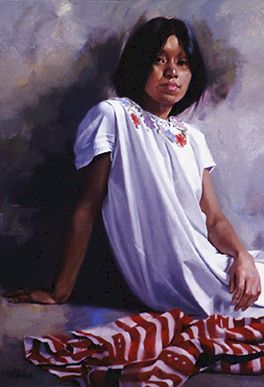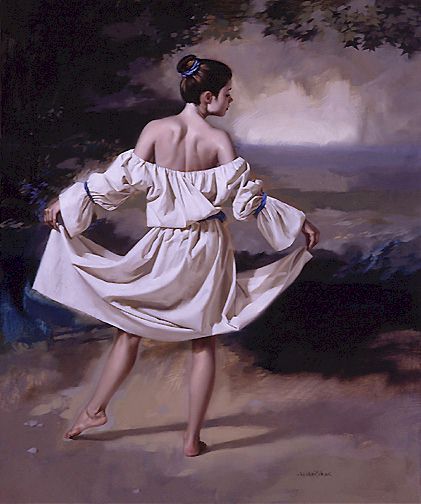|
|
||
|
William Whitaker writes: 'Like everybody else whose worked at painting a long time, I've tried everything. I've learned that Art Leads, I just go along. I didn't consciously set out to be a certain kind of painter, it just evolved. I don't believe there is any one true way, but I'll tell you what I like best. I start loose and juicy. I rarely paint alla prima anymore and I try to smooth out the paint at the end of a session. I dislike the effect when I paint over a textured layer whose texture is in the wrong places. I have a very old, sharp palette knife (sharpened from years of scraping.) I'll carefully scrape texture off a dried surface with it. If I'm working on a panel, I'll often sand the fuzz, texture and grit off the dried paint surface with wet or dry fine sand paper, sanding wet, before painting the next coat - a technique I picked up from house painters.
I'm very aware of what I call "wall presence" or the lack of it. A lot of my best buddies were successful illustrators before they became even more successful gallery painters. They all were smart enough to know and understand that the single most valuable characteristic in a painting on display is the spiritual wall presence. It is easier to achieve this quality with oil paint than with other mediums. This is due to inherent pigment strength and natural body.
There seem to be a great many folks who are doing high finish (they call it realistic) work out there today. Most of these people paint from the outside in - paint the hair on the dog before painting the dog. Most of the time they are pretty easy to spot. I tell the viewer to check out the following: Do they paint Orange People? Thanks to film, TV and Print, most folks think orange people are realistic! Does everything look like plastic? Enough said about that! What do the broad, quiet passages look like. A poor artist doesn't know how to handle his brush. It shows in the backgrounds.
All Paintings on this page are by William Whitaker STUDENT ACTIVITY:Write a short essay on the relationship between size and wall presence, colors and wall presence, design and wall presence. Give examples of each. Also explain how you think William Whitaker gives his paintings such great wall presence. Allow 40min. |


